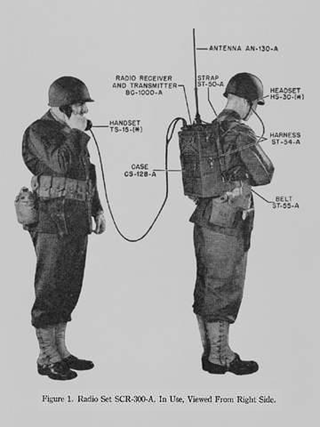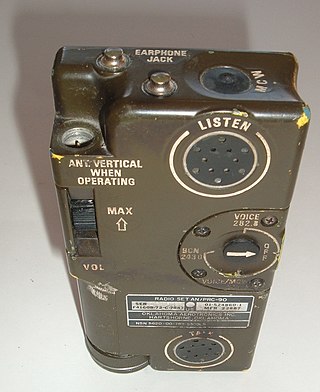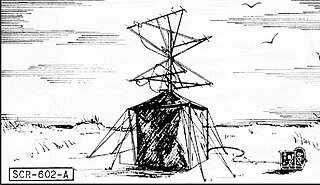The SCR-277 was a mobile, trailer mounted radio range set for radio guidance of aircraft. It was standardized by the U.S. Army in June 1941.
Contents

The SCR-277 was a mobile, trailer mounted radio range set for radio guidance of aircraft. It was standardized by the U.S. Army in June 1941.

The SCR-277 was used as a navigation aid. It included the BC-467 transmitter with an RF output power of 800 watts, the BC-468 Goniometer, and BC-342 receiver. Frequencies utilized were 200-400 kHz for transmission and 1.5-18 MHz for reception. Radio range homing equipment transmitted tone identification signals to aircraft that lacked a radio compass but were equipped with command sets. Range was approximately 300 miles. It was powered by a single PE-90 generator. [1] [2] [3]
In operation the transmitter sends out signals coded "A" or "N" in each of the four quadrants around the beacon. The signals overlap on the range, providing the pilot of the aircraft an indication of his position in relation to location of the beacon. Thus, if he is heading toward the beacon he will receive an aural signal coded "A" or "N" if he is between the beam, and when he is on the beam he will receive "AN" signal. Over land areas the beacon has a range of about 300 miles, while over water areas the range is extended to about 1,000 miles. Charts prepared for air navigation show the position and the orientation of the various beacons. [3]

Radio navigation or radionavigation is the application of radio waves to determine a position of an object on the Earth, either the vessel or an obstruction. Like radiolocation, it is a type of radiodetermination.

The SCR-584 was an automatic-tracking microwave radar developed by the MIT Radiation Laboratory during World War II. It was one of the most advanced ground-based radars of its era, and became one of the primary gun laying radars used worldwide well into the 1950s. A trailer-mounted mobile version was the SCR-784.

The AN/ARC-5 Command Radio Set is a series of radio receivers, transmitters, and accessories carried aboard U.S. Navy aircraft during World War II and for some years afterward. It is described as "a complete multi-channel radio transmitting and receiving set providing communication and navigation facilities for aircraft. The LF-MF-HF components are designed to transmit and receive voice, tone-modulated, and continuous wave (cw) signals." Its flexible design provided AM radiotelephone voice communication and Modulated continuous wave (MCW) and Continuous wave (CW) Morse code modes, all of which are typical capabilities in other Navy aircraft communication sets of the period. It was an improvement of the Navy's ARA/ATA command set. Similar units designated SCR-274-N were used in U.S. Army aircraft. The Army set is based on the ARA/ATA, not the later AN/ARC-5. The ARA/ATA and SCR-274-N series are informally referred to as "ARC-5", despite small differences that render all three series incompatible. Like the AN/ARC-5, the ARA/ATA and SCR-274-N had AM voice communication and two-way MCW and CW Morse code capability.

The SCR-284 was a World War II era combination transmitter and receiver used in vehicles or fixed ground stations.
The Lorenz beam was a blind-landing radio navigation system developed by C. Lorenz AG in Berlin. The first system had been installed in 1932 at Berlin-Tempelhof Central Airport, followed by Dübendorf in Switzerland (1934) and others all over the world. The Lorenz company referred to it simply as the Ultrakurzwellen-Landefunkfeuer, German for "ultra-short-wave landing radio beacon", or LFF. In the UK it was known as Standard Beam Approach (SBA).

Radio is the technology of communicating using radio waves. Radio waves are electromagnetic waves of frequency between 3 hertz (Hz) and 300 gigahertz (GHz). They are generated by an electronic device called a transmitter connected to an antenna which radiates oscillating electrical energy, often characterized as a wave. They can be received by other antennas connected to a radio receiver, this is the fundamental principle of radio communication. In addition to communication, radio is used for radar, radio navigation, remote control, remote sensing, and other applications.

Signal Corps Radios were U.S. Army military communications components that comprised "sets". Under the Army Nomenclature System, the abbreviation SCR initially designated "Set, Complete Radio", but was later misinterpreted as "Signal Corps Radio."

The SCR-299 was a U.S. Signal Corps mobile military communications unit used during World War II.

Survival radios are carried by pilots and search and rescue teams to facilitate rescue in an emergency. They are generally designed to transmit on international distress frequencies. Maritime systems have been standardized under the Global Maritime Distress Safety System. Civil and military organisation's utilized different frequencies to communicate and no infringement on either sector would take place. For emergencies involving civilian aircraft, the radio frequency used is VHF 121.5 MHz and for military aircraft incidents, the frequency used is UHF 243 MHz.

The BC-610 was a radio transmitter based on the Hallicrafters HT-4 and was used by the U.S. Army Signal Corps during World War II.
The AN/MPN is a mobile Ground-controlled approach radar first used during World War II. "MPN" is Joint Electronics Type Designation System nomenclature for (Ground) Mobile (M), Pulsed (P), Navigation aid (N).

The SCR-694 was a portable two way radio set used by the U.S. military during World War II.

The low-frequency radio range, also known as the four-course radio range, LF/MF four-course radio range, A-N radio range, Adcock radio range, or commonly "the range", was the main navigation system used by aircraft for instrument flying in the 1930s and 1940s, until the advent of the VHF omnidirectional range (VOR), beginning in the late 1940s. It was used for en route navigation as well as instrument approaches and holds.
The AN/MRN-1 was an instrument approach localizer used by the Army Air Force during and after World War II. It was standardized on 3 July 1942. It replaced the SCR-241, and was a component of SCS-51.
The AN/MRN-3 was a marker beacon set used by the Army Air Force during and after World War II, it was standardized 23 October 1943, and replaced SCR-241.

The SCR-245 Radio was a mobile MF/HF Signal Corps Radio used by the U.S. Army before and during World War II, for short range ground communications, It was one of the first crystal controlled sets used by the Army.

The SCR-508 radio was a mobile Signal Corps Radio used by the U.S. Army during World War II, for short range ground communications. The SCR-508 series radio represented the Army's commitment to both FM and crystal tuning, and was used extensively by armor and mechanized units. The turret bustle of late series light and medium tanks was designed around this radio.

The K-30 truck, a US Signal Corps designation for an Autocar U8144 truck with York-Hoover van body, was used as the Operating Truck for the SCR-270, an early-warning radar of World War II. 2) 3) 4) Similar vehicles were the K-31 power truck for the SCR-270 early warning radar and K-62 or K-62-A, both operating trucks also for the SCR-270. K-30 and the similar K-62(-A) differed in cubic feet and overall height from the K-31. On the accompanying image in the infobox can be seen, that the K-30 beside in cubic feet and overall height differed from the K-31 in having a window on the right side of the van body. The panels at the back and at both sides were formed by two halves, that were folded up and down respectively. This truck contains a high-power radio transmitter, a cooling system for the transmitter tubes, two cathode-ray oscilloscopes, two superheterodyne receivers, a vacuum-tube keyer, a plotting table, and containers for spare parts and tubes.

The SCR-602 also known as the AN/TPS-3, was a mobile, lightweight, medium-range, early-warning radar utilized by the United States and its allies during World War II. The radar was originally designed for use during the initial stages of an amphibious assault or military operation where its lightweight relative to other radar systems was a distinct advantage. Once larger radars such as the SCR-270 or AN/TPS-1 came online the SCR-602 could also be used to fill in gaps in radar coverage.